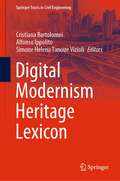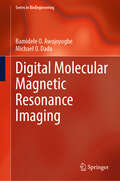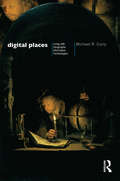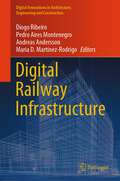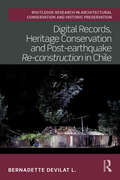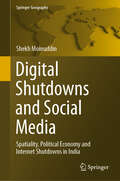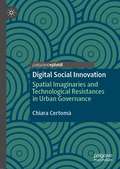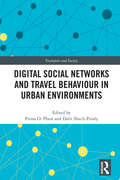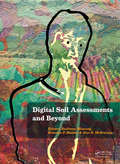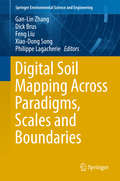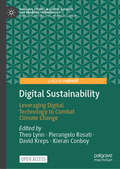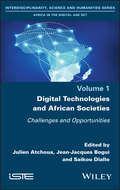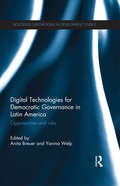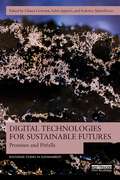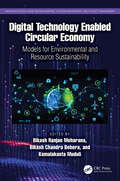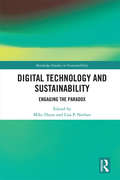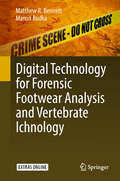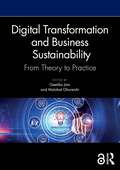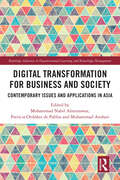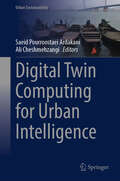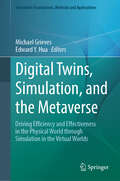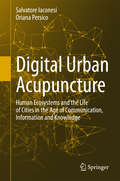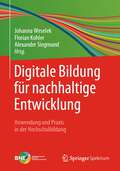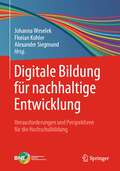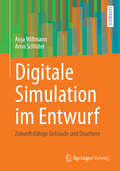- Table View
- List View
Digital Modernism Heritage Lexicon (Springer Tracts in Civil Engineering)
by Cristiana Bartolomei Alfonso Ippolito Simone Helena Tanoue VizioliThe book investigates the theme of Modernism (1920-1960 and its epigones) as an integral part of tangible and intangible cultural heritage which contains the result of a whole range of disciplines whose aim is to identify, document and preserve the memory of the past and the value of the future. Including several chapters, it contains research results relating to cultural heritage, more specifically Modernism, and current digital technologies. This makes it possible to record and evaluate the changes that both undergo: the first one, from a material point of view, the second one from the research point of view, which integrates the traditional approach with an innovative one. The purpose of the publication is to show the most recent studies on the modernist lexicon 100 years after its birth, moving through different fields of cultural heritage: from different forms of art to architecture, from design to engineering, from literature to history, representation and restoration. The book appeals to scholars and professionals who are involved in the process of understanding, reading and comprehension the transformation that the places have undergone within the period under examination. It will certainly foster the international exchange of knowledge that characterized Modernism
Digital Molecular Magnetic Resonance Imaging (Series in BioEngineering)
by Michael O. Dada Bamidele O. AwojoyogbeThis book pushes the limits of conventional MRI visualization methods by completely changing the medical imaging landscape and leads to innovations that will help patients and healthcare providers alike. It enhances the capabilities of MRI anatomical visualization to a level that has never before been possible for researchers and clinicians. The computational and digital algorithms developed can enable a more thorough understanding of the intricate structures found within the human body, surpassing the constraints of traditional 2D methods. The Physics-informed Neural Networks as presented can enhance three-dimensional rendering for deeper understanding of the spatial relationships and subtle abnormalities of anatomical features and sets the stage for upcoming advancements that could impact a wider range of digital heath modalities. This book opens the door to ultra-powerful digital molecular MRI powered by quantum computing that can perform calculations that would take supercomputers millions of years.
Digital Places: Living with Geographic Information Technologies
by Michael CurryBy offering an understanding of Geographic Information Systems within the social, economic, legal, political and ethical contexts within which they exist, the author shows that there are substantial limits to their ability to represent the very objects and relationships, people and places, that many believe to be most important.Focusing on the ramifications of GIS usage, Digital Places shows that they are associated with far-reaching changes in the institutions in which they exist, and in the lives of those they touch. In the end they call for a complete rethinking of basic ideas, like privacy and intellectual property and the nature of scientific practice, that have underpinned public life for the last one hundred years.
Digital Railway Infrastructure (Digital Innovations in Architecture, Engineering and Construction)
by Diogo Ribeiro Pedro Aires Montenegro Andreas Andersson Maria D. Martínez-RodrigoThis book describes the most recent strategies for the digitalization of railway sector that bring new challenges for the construction, operation, and maintenance of railway infrastructures. These strategies involve the development and application of new technologies and methodologies to enhance the sustainability and resilience of railway infrastructures particularly under extreme climate and operational events. In particular, the digital transformation involves the use of digital twins, augmented and virtual reality, forecast capabilities, risk and life-cycle analysis, cybersecurity, unmanned technologies for monitoring and inspection, computer vision, AI, risk and disaster management, among others. Presently, the literature is lacking a contribution that provides general and foundational knowledge across these and other topics. Therefore, this book provides valuable information for researchers, students, and professionals in railway engineering that want to develop their knowledge and skills in this field.
Digital Records, Heritage Conservation and Post-earthquake Re-construction in Chile (Routledge Research in Architectural Conservation and Historic Preservation)
by Bernadette Devilat L.The conservation of built heritage implies constant intervention. One form of intervention is reconstruction, which, in the context of disasters, usually tries to bring buildings and places back to their previous state and is contested in heritage discourses. This book challenges reconstruction as a replica to physically preserve damaged built heritage by critically examining a context of constant change resulting from earthquakes – Chile – advocating for the digital record to be an analytical basis for design, following the principles embedded in historical domestic architecture.Beyond monumental heritage, the focus is on the living heritage of the historical settlements of Tarapacá, Zúñiga, and Lolol, built with local resources and sustainable techniques. The book proposes re-construction as an alternative methodology, based on 3D-laser-scanning, photography, and questionnaires, to analyse the as-built condition of earthquake-affected buildings, consider risk mitigation, and recognise adaptation to earthquakes and subsequent reconstructions. This is relevant for seismic-prone areas and built heritage at risk in general.This book is aimed at researchers, academics, and practitioners in architectural conservation and is also a valuable resource for authorities and stakeholders involved in post-earthquake scenarios.
Digital Shutdowns and Social Media: Spatiality, Political Economy and Internet Shutdowns in India (Springer Geography)
by Shekh MoinuddinThis book offers a spatial insights on the social mediasphere in the context of digital shutdowns and reflects the dimensions of political economy and of social media in general. Internet shutdowns have been found to be more prevalent in developing countries than in developed countries, with India leading in Internet shutdowns in the world. Internet shutdowns have occurred in India for several reasons, mainly to hinder the spreading of information through social media – this is discussed in detail along with political motives behind this and how this can conflict with government policies, such as the flagship program “Digital India” which is ostensibly meant to improve the infrastructure and expansion of digital information throughout the country. This book suggests new dimensions in the digital spatiality. Furthermore, the digital space is defined and discussed, including its role and how this might be reflected in concepts around spatiality and spaces. More concretely, the book considers the following questions: How is social media reflected in spatial sciences? How does the space differ from more tangible spaces, such as the hydrosphere or atmosphere? How do (computer/mobile phone) screens behave as a space/place in the context of behavioural sciences? How is this reflected in what is shaping and reshaping the spatiality of digital gadgets? Do digital gadgets change the socialization process that’s often considered a path towards how we develop in society? How do internet shutdowns affect the political economy and what patterns can be seen in how individuals, companies and the internet industry in particular react to these shutdowns in India?
Digital Social Innovation: Spatial Imaginaries and Technological Resistances in Urban Governance
by Chiara CertomàThis book engages the reader in exploring the relationships between digital social innovation initiatives and the city. It delivers a fresh, accessible and case-based discussion on the emergence of digitally-enabled social innovation practices in Europe that are redesigning the urban space and challenging the consolidated urban governance processes. By adopting a critical geography perspective, this ground-breaking analysis of digital social innovation provides the reader with an accessible overview of the way in which urban reproductive processes mobilise the physical and the virtual dimensions of the city and generate distinctive spatial configurations. Together with novel urban narratives and socio-technical imaginaries, these support the existing geometries of power or construct new ones. The author clearly describes contemporary cities as the new battlegrounds for controlling the digital sphere, shaped by the interplay between digital capitalism and resistance movements. In light of grassroots initiatives advanced by cyber-activists, e-makers and hackers, the book unveils the socio-political and cultural underpinnings of the revolution produced by the digital social innovations in the city and the socio-technological regimes supporting them. This author successfully sheds new critical light on traditional innovation studies exploring the debate on digital innovation through the lens of social and cultural geography providing an invaluable reference for those working in this field.
Digital Social Networks and Travel Behaviour in Urban Environments (Transport and Society)
by Pnina O. Plaut; Dalit Shach-PinslyThis book brings together conceptual and empirical insights to explore the interconnections between social networks based on Information and Communication Technologies (ICT) and travel behaviour in urban environments. Over the past decade, rapid development of ICT has led to extensive social impacts and influence on travel and mobility patterns within urban spaces. A new field of research of digital social networks and travel behaviour is now emerging. This book presents state-of-the-art knowledge, cutting-edge research and integrated analysis methods from the fields of social networks, travel behaviour and urban analysis. It explores the challenges related to the question of how we can synchronize among social networks activities, transport means, intelligent communication/information technologies and the urban form. This innovative book encourages multidisciplinary insights and fusion among three disciplines of social networks, travel behaviour and urban analysis. It offers new horizons for research and will be of interest to students and scholars studying mobilities, transport studies, urban geography, urban planning, the built environment and urban policy.
Digital Soil Assessments and Beyond: Proceedings of the 5th Global Workshop on Digital Soil Mapping 2012, Sydney, Australia
by Budiman Minasny Brendan P. Malone Alex B. McBratneyDigital soil assessments and beyond contains papers presented at the 5th Global Workshop on Digital Soil Mapping, held 10-13 April 2012 at the University of Sydney, Australia. The contributions demonstrate the latest developments in digital soil mapping as a discipline with a special focus on the use of map products to drive policy decisions partic
Digital Soil Mapping Across Paradigms, Scales and Boundaries
by Feng Liu Gan-Lin Zhang Dick Brus Xiao-Dong Song Philippe LagacherieThis book contains papers presented at the 6th Global Workshop on Digital SoilMapping, held 11-14 November 2014 at the Institute of Soil Science, ChineseAcademy of Sciences of Nanjing, China. Digital soil mapping is advancing ondifferent fronts at different paces throughout the world. The researches andapplications on DSM are moving from method development to realizations indifferent scales and regions, serving the generation of national andcontinental to global soil grids. Meanwhile, new ideas and insights on mapping complex soil-landscapes such as flat plains,anthropogenically altered agriculture and urban spaces are emerging, with the help of new paradigms and models. The goal of the sixth workshop was to review and discuss the state ofthe art in digital soil mapping, and to explore strategies for bridgingresearch, production, and environmental applications. Thisbook provides a very useful and comprehensive overview of the status of digitalsoil mapping, in which graduate students, scientists and specialists workingwithin the field of geography can find the spatial prediction approaches andrelated theory.
Digital Sustainability: Leveraging Digital Technology to Combat Climate Change (Palgrave Studies in Digital Business & Enabling Technologies)
by Kieran Conboy David Kreps Theo Lynn Pierangelo RosatiDigitalisation and environmental sustainability are two of the megatrends impacting industry and society. This open access Pivot is a timely exploration of some of the challenges and prospects related to digital sustainability from two main perspectives: how digital technologies can be used and maintained in a way that is environmentally sustainable over the long term (greening of digital technologies), and how digital technologies can be used to address climate change and improve environmental and sustainability outcomes (greening by digital technologies). The chapters included in this book are designed to provide some key definitions and concepts related to digital sustainability and its evolution, and more detailed insights on some of the key priority areas outlined in the European Green Deal, namely energy, mobility, buildings, food and the circular economy. A critical review of these topics will summarise and present different perspectives that challenge old assumptions and highlight emerging trends and possibilities for digital sustainability. Industry and society face significant challenges in the twin transition to digital and green transformation, not least of which is the need to balance investment in digital technologies with environmental sustainability. This open-access book can serve as a primer for scholars, policymakers, and enterprise decision-makers, providing insights on navigating innovation ecosystems to support both green and digital objectives.
Digital Technologies and African Societies: Challenges and Opportunities
by Saikou Diallo Julien Atchoua Jean-Jacques BoguiThe integration and use of information and communication technologies (ICT) in African countries is increasingly observable in various sectors of activity (banking, education, trade, etc.) despite a digital divide still relevant. ICT has become a major sector of the recent growth of a new informal economy in African cities (Chéneau-Loquay, 2008). This question has been at the heart of various international meetings. An overall positive and even utopian momentum is generally heard about the contribution of digital technologies to the development of African states. The adoption or appropriation of digital technologies by Africans is presented in many speeches by politicians or institutions involved in the field of cooperation and international development as an important issue for the development of this continent. These different considerations give rise to reflections on the following themes. - Social Media and Public Space in Africa - Challenges of the digital economy in Africa - ICT and modernization of higher education in Africa
Digital Technologies for Democratic Governance in Latin America: Opportunities and Risks (Routledge Explorations in Development Studies)
by Yanina Welp Anita BreuerThis book is the first to comprehensively analyse the political and societal impacts of new Information and Communication Technologies (ICT) in a region of the Global South. It evaluates under what conditions some Latin American governments and people have succeeded in taking up the opportunities related to the spread of ICTs, while others are confronted with the pessimist scenario of increased, digitally induced social and democratic cleavages. Specifically, the book examines if and how far the spread and use of new ICT affected central aims of democratic governance such as reducing socio-economic and gender inequality; strengthening citizen participation in political decision making; increasing the transparency of legislative processes; improving administrative processes; providing free access to government data and information; and expanding independent spaces of citizen communication. The country case and cross-country explore a range of bottom-up driven initiatives to reinforce democracy in the region. The book offers researchers and students an interdisciplinary approach to these issues by linking it to established theories of media and politics, political communication, political participation, and governance. Giving voice to researchers native to the region and with direct experience of the region, it uniquely brings together contributions from political scientists, researchers in communication studies and area studies specialists who have a solid record in political activism and international development co-operation.
Digital Technologies for Sustainable Futures: Promises and Pitfalls (Routledge Studies in Sustainability)
by Chiara Certomà Fabio Iapaolo Federico MartellozzoThis book critically examines the interplay between digitalization and sustainability. Amid escalating environmental crises, some of which are now irreversible, there is a noticeable commitment within both international and domestic policy agendas to employ digital technologies in pursuit of sustainability goals.This collection gathers a multitude of voices interrogating the premise that increased digitalization automatically contributes to greater sustainability. By exploring the planetary links underpinning the global digital economy, the book exposes the extractive logics ingrained within digital capitalism and introduces alternatives like digital degrowth and the circular economy as viable, sustainable paths for the digital era. Through a combination of theoretical reflections and detailed contextual analyses from Italy, New Zealand, and the UK—including initiatives in participatory planning and technology co-design—it articulates the dual role of digital technology: its potential to support socio-economic and environmental sustainability, while also generating conflicts and impasses that undermine these very objectives. Offering fresh insights into power disparities, exclusionary tactics, and systemic injustices that digital solutionism fails to address, this volume also serves as a reminder that sustainability extends beyond climate-related issues, underscoring the inseparability of environmental discourse from wider social justice considerations.Aimed at a diverse readership, this volume will prove valuable for students, researchers, and practitioners across various fields, including Geography, Urban Studies, Sustainability Studies, Environmental Media Studies, Critical AI Studies, Innovation Studies, and the Digital Humanities.
Digital Technology Enabled Circular Economy: Models for Environmental and Resource Sustainability (Advances in Intelligent Decision-Making, Systems Engineering, and Project Management)
by Kamalakanta Muduli Bikash Chandra Behera Bikash Ranjan MoharanaThis book presents cutting-edge findings that draw on the use of AI, the Industrial Internet of Things, Blockchain, and Co-Analytics for the development of Circular Economy (CE) models to make organizational activities more sustainable. A further goal is the development of Digital Technology (DT)–enabled support tools that can be used to further analyze the impact of DT and CE–enabled operational practices used to achieve resource and environmental sustainability.Digital Technology Enabled Circular Economy: Models for Environmental and Resource Sustainability discusses the integration of digital technology-enabledcircular economy models into the manufacturing industries and its advantages for sustainability. It emphasizes the fundamentals and applications and their enactment, as well as integration for the overall organizational development. The book explains the role of digital technologies in food supply chains and multi-life cycle materials for sustainable development and highlights the development of the workforce to facilitate the implementation of smart and advanced technologies. This book presents the development of DT–enabled support tools used to analyze the impact of DT and CE–enabled operational practices on an organization and efforts to achieve resource and environmental sustainability. Case studies that demonstrate how smart digital technology can help firms improve their long-term performance by embracing circular operation methods are also included.Students, academicians, and researchers, as well as managers and stakeholders who are interested in smart, sustainable production, and consumption, together with managers and stakeholders who are interested in ways of implementing them in their organizations, will find this book of interest. It will demonstrate, via the use of real-world case studies, how smart digital technology can help firms improve their long-term performance by embracing circular operating methods.
Digital Technology and Sustainability: Engaging the Paradox (Routledge Studies in Sustainability)
by Mike Hazas Lisa NathanThis book brings together diverse voices from across the field of sustainable human computer interaction (SHCI) to discuss what it means for digital technology to support sustainability and how humans and technology can work together optimally for a more sustainable future. Contemporary digital technologies are hailed by tech companies, governments and academics as leading-edge solutions to the challenges of environmental sustainability; smarter homes, more persuasive technologies, and a robust Internet of Things hold the promise for creating a greener world. Yet, deployments of interactive technologies for such purposes often lead to a paradox: they algorithmically "optimize" heating and lighting of houses without regard to the dynamics of daily life in the home; they can collect and display data that allow us to reflect on energy and emissions, yet the same information can cause us to raise our expectations for comfort and convenience; they might allow us to share best practice for sustainable living through social networking and online communities, yet these same systems further our participation in consumerism and contribute to an ever-greater volume of electronic waste.By acknowledging these paradoxes, this book represents a significant critical inquiry into digital technology’s longer-term impact on ideals of sustainability. Written by an interdisciplinary team of contributors this book will be of great interest to students and scholars of human computer interaction and environmental studies.
Digital Technology for Forensic Footwear Analysis and Vertebrate Ichnology
by Matthew R. Bennett Marcin Budka“There is no branch of detective science which is so important and so much neglected as the art of tracing footsteps. Happily, I have always laid great stress upon it, and much practice has made it second nature to me.” Sherlock Holmes, Study of Scarlet.Despite the fictional nature of Sherlock Holmes this statement rings true today. The study of footwear is neglected in modern forensic practice and does have much to offer. What it needs is an injection of technology and modern analytical tools. These tools are emerging from the digital revolution currently transforming vertebrate ichnology. Ichnology is the discipline of earth science which focuses on the study of trace fossils such as footprints. This book draws upon both disciplines - geology (ichnology) and forensic science - to show how the two have much to learn from each other especially with regard to the digital capture and analysis of footprints. This book presents field and laboratory methods associated with the collection, analysis and presentation of three-dimensional tracks (footprints) whether from a crime scene or a geological/archaeological excavation. It shows students, researchers and practitioners how to collect and analyse 3D data and take advantage of the digital revolution transforming ichnology. This book is not only essential reading for forensic and earth science students but also for professional forensic practitioners as well as for applied computer scientists developing new tools for visualization and analysis of 3D data. The book forms a natural methods focused complement to the successful text Fossilised Locomotion published by Springer 2014.
Digital Transformation and Business Sustainability: From Theory to Practice
by Geetika Jain Malahat GhoreishiDigital transformation brings new opportunities, but also disruption, to the way businesses work. The application of technologies such as blockchain, AI, Internet of Things (IoT) and Big Data has the potential to revolutionize how businesses operate and incorporate sustainable practices within manufacturing processes and supply chains, creating value and redeveloping business models. Digital technologies can also enable more efficient collaboration between various partners across the globe and increase transparency in the supply chain. But while the adoption of new technology can have benefits for businesses, customers and the environment, individual businesses’ uptake of new technologies is highly variable, leading to disruption in the supply and value chains.Digital Transformation and Business Sustainability: From Theory to Practice provides insights into the principle of digital transformation and the key technologies that enable businesses to put the principle into practice. The early chapters set out what digital transformation means for business and how an organization can be ready for it. This book then asks a series of critical questions about digital transformation, such as whether it enables inclusive markets and how compatible it is with digital inclusion and the UN’s Sustainable Development Goals. The issue of business sustainability is then addressed in a series of chapters looking at digital transformation and the circular economy.Featuring diverse cases and examples drawn from across the global economy, and assessing both the theory and practice of digital transformation, this book is an ideal resource for postgraduate students on management courses, professionals on executive education courses, researchers and lecturers.Chapter 3 of this book is freely available as a downloadable Open Access PDF at http://www.taylorfrancis.com under a Creative Commons Attribution-NonCommercial (CC-BY-NC) 4.0 license.
Digital Transformation for Business and Society: Contemporary Issues and Applications in Asia (Routledge Advances in Organizational Learning and Knowledge Management)
by Mohammad Nabil Almunawar, Patricia Ordóñez de Pablos and Muhammad AnshariThe advancement of technology, such as data analytics and AI, has led to the birth of Industry 4.0, in which technology seems to be at the centre of development. However, as the COVID-19 pandemic created havoc, the entire world production chain was seriously affected, highlighting that machines alone, although fully connected and automated, cannot function without people. This book addresses contemporary issues and the impact of digital transformation on individuals, businesses and governments in Asia. As Asian nations are moving fast towards the digital economy, this edited collection offers new perspectives on understanding emerging business opportunities as well as the challenges faced. Chapters explore the variables that accelerate digital transformation, notably the COVID-19 pandemic, the rapid development of information and communication technology, AI, big data and affordable internet access, and their impact on business and society. With rich, empirical studies from leading researchers, this book will be a reference for academics and scholars across business disciplines, including information, technology and innovation management, organisational and strategic management, as well as those interested in industrial development.
Digital Twin Computing for Urban Intelligence (Urban Sustainability)
by Ali Cheshmehzangi Saeid Pourroostaei ArdakaniDigital Twin Computing for Urban Intelligence focuses on new and ongoing discourses in interdisciplinary research and practice in urban system and smart city development pathways. It approaches digital twin fundamentals and principals including theoretical foundations, conceptualisations, strategies and services/patterns to define and adapt digital twin solutions for urban applications - mainly sustainability. This book highlights promising case studies and outlines digital twin design models and system architecture by examining key digital twin deployment practices such as data analysis, decision making, and service automation in the line with intelligent urban planning. It also emphasises on DT technologies such as cloud computing, AI, IoTs, and smart virtualisation and outlines the key benefits of the DT solutions in urban applications - mainly control and planning. This book is intended for a wide range of audiences, including interested layperson audiences, undergraduate and graduate students in university, and researchers. The key benefits of this book are: 1- To introduce the theoretical principles and fundamentals of DT computing for urban intelligence. 2- To present the state-of-the-art DT technologies in urban planning and control. 3- To describe the practical deployment process of DT computing solutions for urban sustainability and intelligence.
Digital Twins, Simulation, and the Metaverse: Driving Efficiency and Effectiveness in the Physical World through Simulation in the Virtual Worlds (Simulation Foundations, Methods and Applications)
by Michael Grieves Edward Y. HuaDive into the fascinating world of Digital Twins, Simulation, and the Metaverse, where the virtual/digital and physical worlds collide and reshape industries. This book offers an insightful exploration of the revolutionary applications of these technologies, promising to ignite your imagination and inspire innovation. The topics described in this book represent a groundbreaking exploration of the synergistic relationship between digital twins, simulation, and the metaverse, as well as their transformative impact across various sectors. In addition to presenting theoretical discussions and experimental findings, this book focuses on real-life applications and illuminates the path for future research. This makes it a must-read for both industry and academia keen on understanding and harnessing the power of the emerging technologies. Topics and features: Discover from top thought leaders the predictions of how digital twins, simulation, and metaverses will evolve in direction, requirements, and capabilities Exploit the understanding of how digital-twin metaverses will revolutionize the effectiveness and efficiency of 21st-century work Explore cutting-edge, real-life applications of digital twins, simulation, and the metaverse (spanning a diverse array of industries and sectors) Understand the different views and perspectives of digital twins and metaverses shared by academia, industry, and government authors from around the world Learn how to harness the power of simulation in the world of digital twins and metaverses This unique volume consists of works from internationally renowned experts representing a diverse array of industries and sectors. It will be eminently suitable for researchers and practitioners working on modeling and simulation, digital twins, and the metaverse. Furthermore, this volume will serve as a valuable reference for executives and decision makers who are looking to leverage these cutting-edge technologies to expand their businesses, develop industrial and national strategies, and support future missions.
Digital Urban Acupuncture
by Salvatore Iaconesi Oriana PersicoThis book explores the possibility to observe the lives of cities through ubiquitous information obtained through social networks, sensors and other sources of data and information, and the ways in which this possibility describes a new form of Public Space, which can be used to define new forms of citizenship and participated city governance. The work is the result of years of research across sciences, arts, design, ethnography, cultural geography, performed by multiple researchers, understanding the Relational Ecosystems of cities (the flows of relation, information, knowledge and emotion in the city) and using them to reinterpret the concept of Urban Acupuncture: from the Third Space, Third Landscape and Third Generation City, to the Third Infoscape; from Urban Acupuncture to Digital Urban Acupuncture. The book starts by exploring the many theories and methodologies which have been used to try to capture and use the revolutionary potential found in the daily lives of cities. From De Certeau, to Latour, Bateson, Bhabha, and all the way to Castells, Clèment, Boyd, Casagrande. In a progression which moves from the Third Space (Soja, De Certeau), to the Third Landscape (Clèment), to the Third Generation City (Casagrande), to the Third Paradise (Pistoletto), the book arrives at a definition of the Third Infoscape, following up on Kevin Lynch: a new legibility and imageability of the city. Its main themes and objectives lie in the desire to observe and understand the radical transformation of the definitions, boundaries and configurations of what we call public and private spaces, in different cultures and communities, in the age of communication, information and knowledge, and to use these understandings to formulate a set of working hypotheses for the positive, constructive, active and participatory usage of these transformed scenarios, contributing to the re-definition of concepts such as citizenship, city-governance, urban planning, civic decision-making, and more. And using, in the process, techniques such as Urban Acupuncture, Actor-Network Theory, Diasporic analysis, Peer-to-peer Urbanism and more. Multiple real-life research scenarios and documented case studies will be used, from 4 continents, coming from our research and from other international contributions.
Digitale Bildung für nachhaltige Entwicklung: Anwendung und Praxis in der Hochschulbildung
by Johanna Weselek Florian Kohler Alexander SiegmundWie kann digitale Bildung für nachhaltige Entwicklung (BNE) an Universitäten und Hochschulen konkret umgesetzt werden? Wie können Lehrveranstaltungen und Lehr-Lern-Räume gestaltet werden, um Hochschulbildung verstärkt zukunftsfähig zu machen? Wissenschaftler*innen der Natur-, Sozial-, Geistes- und Kulturwissenschaften liefern zahlreiche Beispiele einer praktischen Umsetzung für Hochschullehrende. Vielfältige Impulse werden gesetzt und Möglichkeiten für erfolgreiche Lehr-Lern-Settings vorgestellt – von der Nutzung verschiedener Apps über digitale Experimentierkoffer und Spiele bis hin zu virtuellen Exkursionen. Das breit gestreute Themenspektrum reicht vom Klimawandel und Naturschutz bis hin zu zukunftsorientiertem und diversitätssensiblem Informatikunterricht und der digitalen Transformation in der Fremdsprachendidaktik. Theoretische und praktische Konzepte zeigen die disziplinär und thematisch vielfältige Bandbreite und Beispiele aus der Lehrkräftebildung unterstreichen, welche zentrale Rolle diese für die Gestaltung einer sozial-ökologischen Transformation der Gesellschaft einnehmen. Ziel dieses Buches ist es, über Disziplin- und institutionelle Grenzen hinweg den notwendigen Wandel von Denk- und Handlungsweisen im Kontext einer nachhaltigen Entwicklung zu fördern und eine zukunftsorientierte Hochschulbildung zu gestalten.
Digitale Bildung für nachhaltige Entwicklung: Herausforderungen und Perspektiven für die Hochschulbildung
by Johanna Weselek Florian Kohler Alexander SiegmundWarum brauchen wir eine digitale Bildung für nachhaltige Entwicklung (BNE) an Universitäten und Hochschulen? Wie können Lehr-Lern-Räume zu einer zukunftsgerichteten und zukunftsfähigen Hochschulbildung transformiert werden? Diese und weitere vielfältige Fragen behandeln Wissenschaftler*innen der Natur-, Sozial-, Geistes- und Kulturwissenschaften aus ihren jeweils unterschiedlichen, facheigenen Perspektiven.Das vorliegende Buch gibt Einblicke in die theoretische Auseinandersetzung mit nachhaltigkeitsrelevanten Themen wie Verantwortung, Transformation, Naturverständnis oder Werten und Normen sowie den vielfältigen grundlegenden Herausforderungen und Möglichkeiten einer digitalen Hochschulbildung für nachhaltige Entwicklung. Es bietet eine inhaltliche Breite von Themen einer BNE und stellt Hochschullehrenden verschiedene Anwendungsbereiche und Anknüpfungsmöglichkeiten an die digital geprägte Lebenswelt von Lernenden vor. Kritische Reflexionen veranschaulichen, vor welchen Herausforderungen und Grenzen digitale Hochschullehre im Kontext einer BNE steht.Ziel dieses Buches ist es, über Disziplin- und institutionelle Grenzen hinweg den notwendigen Wandel von Denk- und Handlungsweisen im Kontext einer nachhaltigen Entwicklung zu fördern und eine zukunftsorientierte Hochschulbildung zu gestalten.
Digitale Simulation im Entwurf: Zukunftsfähige Gebäude und Quartiere
by Anja Willmann Arno SchlüterDieses Lehrbuch zeigt Möglichkeiten auf, wie Architekt/innen mithilfe vereinfachter dynamischer Simulationen bereits in den ersten Entwurfsphasen klimatische und energetische Konzepte auf verschiedenen Maßstäben auf ihre Wirksamkeit hin überprüfen und in den Entwurf integrieren können. Der thermische Komfort im Innenraum gibt Auskunft über die Behaglichkeit des Nutzers und kann mit dem Einsatz passiver Strategien in Form von Konstruktion, Materialwahl, Lüftungsstrategien, Pufferzonen, Solare Gewinne etc. bewusst erhöht werden, bevor ergänzend gebäudeintegrierte Technologien oder urbane Infrastrukturen zur Energieproduktion oder Versorgung zum Einsatz kommen. Neben den physikalischen Grundlagen und Wirkungsweisen passiver Strategien in verschiedenen Klimazonen werden die Möglichkeiten in Kombination mit aktiven Technologien erläutert, um komfortable, treibhausgasneutrale Gebäude zu entwerfen. Auf städtischer Ebene werden die Wechselwirkungen zwischen Gebäuden, städtischen Rahmenbedingungen und Infrastruktur erläutert und anhand von Beispielen aufgezeigt. Mit dem City Energy Analyst wird ein Werkzeug vorgestellt, mit dem Energieströme in Quartieren unter Berücksichtigung passiver und aktiver Ansätze simuliert und Strategien zur Dekarbonisierung entwickelt werden können.
